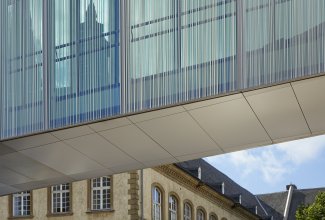Summary record
Video
Operation of the Rent Committee
Question posed by David Wagner
1) What procedure does the Rent Committee (Commission des loyers) follow when investigating claims? Is the procedure governed by clear and transparent criteria?
The scope of authority, composition and operation of the Rent Committee are governed by and plainly set forth in the Law of 21 September 2006 on residential leases, as amended (loi modifiée du 21 septembre 2006 sur le bail à usage d'habitation), specifically Articles 7 et seq.
This law stipulates the conditions in which cases can be referred to the Committee, the procedure to be followed, and the criteria to be used when assessing rents. Debates must take place in the presence of all parties, who must have been formally summoned and be allowed to express their views.
The Committee has no specific budget of its own, and has no special investigative powers. If the claim is in connection with a furnished rental property, and should the Committee deem it useful, the Committee will visit the premises to check the state of the furniture and accommodation. If one of the parties wishes to engage the services of an expert, the Committee shall not object, provided the costs are borne by the party in question.
2) Is the Rent Committee required to justify its decision?
The Rent Committee is a joint body that operates on a parity basis; it is not a court. It comprises four members: a Chair (a legal expert), a Landlord Assessor, a Tenant Assessor, and a Secretary.
Its main task is to reconcile the parties involved in a claim. Most claims brought before the Rent Committee are resolved by an agreement between the parties, which is signed by the landlord, the tenant and the chairperson.
The Rent Committee does not deliver a judgement, in the sense that it has no power to rule against one or the other party. It comes to reasoned decisions, based mainly on supporting documents put forward. It sets rents based on legal and regulatory criteria.
3) Has the College of Aldermen made any enquiries into the investigative procedure used in the specific case mentioned above?
By law, the Rent Committee is an independent body. As such, the College of Aldermen cannot interfere with its work or decision-making process. Only the legal authorities have the power to do so. Should the parties fail to reach agreement, each party may lodge an appeal against the Committee's decision in a magistrates' court. They may also appeal the court's decision.
4) Is there any truth to the statement in the press alleging that the Chair of the Rent Committee had suggested to the claimant that they withdraw their claim? If so, on what basis could the Chair have made such a suggestion? Is the College of Aldermen of the view that, in this specific case, the Rent Committee acted in a professional and ethical manner? Can the report on this case be made available to the municipal council?
The Committee has made it known that, in the 40 years that the current Chair has presided over the Committee, neither his nor his Assessors' work has ever been criticised. The Committee wishes to point out that claimants' requests, which are deemed applications rather than claims, are generally withdrawn once the Committee has explained its findings during a sitting. Once they acknowledge the legislation in force, a fair number of claimants withdraw their application spontaneously, often to avoid the heavy costs of engaging an expert, which is pointless for the parties, and especially for the claimant.
Except for the Committee's ruling and the minutes of the arrangement, there are no special reports provided for in any legal or regulatory texts. As such, the Committee believes that it acted in line with its mission.
5) Lastly, does the Rent Committee produce an annual report that, without revealing the parties' identities, spells out the grounds for claims lodged with the Committee, the procedures undertaken and their outcomes, the results obtained, and the reasons for not following up on certain cases? If not, should such a report not be produced and made public?
Every year, the Secretary compiles an anonymous list of the cases brought before the Committee. For each case, the record states the claimant's capacity (as landlord or tenant) and the outcome (arrangement, withdrawal or decision). This list is compiled for statistical purposes, and is included in the Service Logement's (Housing Department's) annual activity report, which is forwarded to the municipal council along with that department's annual budget. Please see below an excerpt of the activity report for 2018.
Attachment: excerpt in connection with the Rent Committee, from the Service Logement's annual activity report for 2018)
"3.10. Rent Committee
3.10. Secretariat of the Rent Committee
The Service Logement provides secretarial duties for the Rent Committee. The Rent Committee was set up under the Law of 2 October 2006 on leases (loi du 2 octobre 2006 sur le bail à loyer).
The members of the Rent Committee are appointed by the municipal council, with the approval of the Minister for Home Affairs (Ministre de l'Intérieur), for a term of six years. Their terms may be renewed, following the general elections of the municipal councils, within three months of the elected councillors' taking up their posts (Article 7 of the aforementioned law). As such, the members were appointed on 9 February 2018, and the number of Rent Committee sessions was reset to one.
The Rent Committee is composed of the following members:
- Jean-Marie Bauler, Chair
- Ferdinand Burg, Deputy Chair
- Paul Ries, Landlord Assessor
- Robert Conrad, Deputy Landlord Assessor
- Christiane Philipp, Tenant Assessor
- Alphonse Schroeder, Deputy Tenant Assessor
- Paul Schon, Secretary
- Anouk Speltz, Deputy Secretary
When the landlord and tenant fail to agree as to a reasonable rent, and the parties fail to reach an amicable arrangement, the landlord may file an application with the Rent Committee to increase the rent. Tenants, for their part, may apply to the Rent Committee for a rent reduction.
The Rent Committee shall then convene a meeting to rule on the applications filed.
In its role as arbitrator, the Rent Committee provides a framework for settling disputes amicably. It has proven to be very effective in this respect, as many disputes are resolved by arrangement rather than through legal proceedings.
This procedure is open to all tenants and owners of residential lease properties.
In 2018, there were 11 cases brought before the Rent Committee (15 in 2017).
The Rent Committee met to rule on 3 applications lodged by landlords to increase their rent, and on 8 applications lodged by tenants to have their rent reduced:
- 1 amicable arrangement was reached;
- 3 cases were deemed inadmissible;
- 4 cases were ruled on; and
- 3 cases were withdrawn."
Trees in public spaces
Question posed by François Benoy
I would like to put the following questions to the College of Aldermen:
1. The 20,000 plus trees in Luxembourg City serve an important purpose in that they provide oxygen and shade, filter dust and serve as habitats for animals. Many of these trees are located on public thoroughfares and are exposed to stressful conditions. These trees are also crucial for climate adaptation in urban areas.
- What are the College of Aldermen's plans to increase Luxembourg City's tree population?
2. In particular, trees are often in poor condition due to insufficient space, highly compacted soil, discarded rubbish, parked bikes and improper use as a place for dogs to relieve themselves.
- What are the guidelines for the planting of trees in Luxembourg City?
- What dimension and depth criteria does Luxembourg City apply to ensure that the trees can grow enough roots and survive ever-longer periods of drought?
- Are forest experts consulted for all construction projects to ensure that the trees have enough space?
3. Boulevard de la Fraternité is undergoing renovation. The amount of space around the trees was insufficient and appears not to have been increased. Many of the trees along this street in Bonnevoie have not survived.
- Has allowance been made for enough space around the trees along Boulevard de la Fraternité to ensure the survival of the tree population? Will trees be replanted along the entire street?
4. In Luxembourg City, it is becoming increasingly common to fill the space around trees with aggregate, as is the case on Rue Chingiz T. Aitmatov. This does not seem very helpful for promoting biodiversity or pollinators, nor is it aesthetically pleasing.
- What is the purpose of using this method?
- What aggregate is used? Has weed barrier fabric also been laid?
- How is this method compatible with the goal of promoting biodiversity in urban areas?
- Isn't there a risk that this aggregate will be washed away by the rain and swept into the wastewater?
5. To improve the condition of trees and involve the public, on 7 May 2019 I presented the College of Aldermen with a proposal to create a tree sponsorship programme. The College of Aldermen responded favourably to this proposal.
- When and how would you like to implement it?
Response provided by Serge Wilmes
Thank you for asking this question as trees are important to all of us. Since the 1990s, the City of Luxembourg has been keeping a register of trees in public spaces. To date, nearly 21,000 trees have been recorded in the register. Every tree has an "identity card" that enables the municipal departments to track its health status. The City makes sure that trees are planted in places where they can grow properly and that they have the space they need.
Since 2012, saplings have also been recorded in the tree register. Some 300 saplings are added every year; these may be new trees or trees replacing others that had to be removed.
The Service Parcs (Parks Department) follows the Richtlinie Forstentwicklung und Landschaftsbau (Forestry Development and Landscaping Guidelines) to determine the choice of trees, the optimal conditions and the locations best suited to the type of tree. The municipal departments follow these guidelines, for example, to determine the volume required to plant a tree (between 8 and 12 m3) and the required depth (1.5 m minimum).
We do not need to consult outside experts because we are fortunate to have experts within the Service Parcs, particularly Mr Kirch, who is head of the arboriculture support department. However, forest wardens are consulted when it is necessary to decide whether to keep a tree.
The Service Parcs has told me that it was not involved in the roadworks on Boulevard de la Fraternité that Councillor Benoy is referring to.
The aggregate Councillor Benoy mentioned is made of a volcanic mineral from the Eifel region. This aggregate slows weed growth and is completely harmless. This method is much more biodiversity-friendly than the methods applied in the past. The municipal departments have been asked to stop using weed barrier fabric.
The tree sponsorship project is on hold due to the COVID-19 pandemic, but we hope to implement it as soon as possible.
Response provided by François Benoy
I would be grateful if the College of Aldermen could also answer the third part of my question.
Response provided by Lydie Polfer
The College of Aldermen will send you the response in writing.
Protection of trees during private construction work
Question posed by François Benoy
The special development plan (plan d'aménagement particulier – PAP) for the "Car-free living" eco-district in Limpertsberg provides for the incorporation of the European beech from the former grounds of the Maison Bourg-Gemen. This is an extraordinary tree that is protected by both the PAP and the general development plan (plan d'aménagement général). Photos I received on 11 June and forwarded that same day to the Service Urbanisme (Urban Planning Department) and the environmental officer show that the developer did not protect the tree in keeping with the guidelines and that the roots were damaged considerably. Unfortunately, the survival of this tree is not certain.
Hence my questions:
- Regarding the extraordinary tree in the "Car-free living" PAP:
- Did the developer protect the tree in question in keeping with the guidelines?
- What observations did the City's departments make?
- Was the tree damaged? In what way?
- What are the risks for the tree? What are its chances of survival?
- What are the consequences for the developer? How has the City followed up on this matter?
- Regarding the protection of trees and other habitats during construction work, particularly within the framework of PAPs:
- What instructions does the City of Luxembourg give to project owners as regards the protection of trees and habitats?
- How does the City oversee protection in keeping with the guidelines?
- Does the City of Luxembourg conduct on-site inspections to check whether habitats have been protected without being damaged?
- What measures are taken if it turns out that the natural elements in question have not been protected?
- How many habitats are you aware of that have been illegally destroyed during construction work over the past few years?
Response provided by Serge Wilmes
The law of 19 January 2004 on the protection of nature and natural resources (Loi du 19 janvier 2004 concernant la protection de la nature et des ressources naturelles) contains provisions on protecting trees as part of construction projects. On this basis, the College of Aldermen has produced guidelines that developers are required to comply with. In addition, an information campaign on this topic has been launched.
For work planned within a perimeter of less than five metres around a tree, the Service Parcs must be notified at least two weeks before the work commences. The Service Parcs then partners with the Service Coordination des chantiers (Work Site Coordination Department) to determine protection measures in keeping with the guidelines and to write them into the specifications. An inspection is carried out and a full report drawn up before work begins. A special scale stipulates penalties for any failure to abide by the rules. Businesses must have an appropriate insurance policy.
The Service Parcs conducts regular inspections, but there are many work sites in Luxembourg City and it appears that in this case, things did not go as planned. The photos you sent us show that the tree was not protected in keeping with the guidelines. At this time, it is difficult to assess the implications for the tree's health.
Response provided by Lydie Polfer
I can note only that the area around the tree has not changed. During the planning process, we worked hard to ensure that this tree would be protected. One of the first things I put in place in January 2014 was the preservation of the former preschool, the Maison Bourg-Gemen. The developer was notified that they needed to modify their plans to do this, and this would generate less income for them. The College of Aldermen also stressed that this tree had to be protected.
The City of Luxembourg itself has protected an impressive tree in the Lëtzebuerg City Museum's inner courtyard with a wooden fence. Unfortunately, this tree contracted a disease. We are carefully tending to it, but we are not sure if it will survive.
Park in the Pétrusse Valley and the apparent building of a roadway through the wood
Question posed by Héloïse Bock
I am asking this question to learn about the nature of the works underway in the Pétrusse Valley. It appears that a roadway has been built to directly connect a new residence containing luxury apartments to the road network. This is the only property in this area that has direct access to the Pétrusse. In addition, the land opens out onto the park in the valley.
Several years ago, I was notified that the City had purchased this property and that there would be a study to determine how the playground and fitness area could be enlarged. Hence my question: what is the land status of this site, bearing in mind that a scouts centre was located there in the past? If the City is the owner, I would like to know about the future plans for this land. If the City is not the owner, I would like to know what has been authorised.
Trees have been cut down. Is the College of Aldermen willing to take additional steps to safeguard the park in the Pétrusse Valley as a wooded, natural park?
The work site could be better organised in terms of equipment storage. Sewer equipment and 15-metre-high "mountains" of sand have been stored there. Would it be possible to reorganise the delivery of equipment so as to avoid storing it around the park? In addition, equipment belonging to Keren for construction on the Beggen water treatment plant has been there for eight or nine years. When can this equipment be removed?
Is the fence completely surrounding the skate park truly necessary? I think this fence might give lorry drivers crossing the park a false sense of security and encourage them to drive faster.
Response provided by Serge Wilmes
The land in question does not belong to the City of Luxembourg. The mayor will request more detailed information from the municipal departments and we will forward it to you. Generally speaking, the City wants to protect the trees in the Pétrusse Valley. You are familiar with the land restoration project approved by the municipal council. I would like to remind you that we will try to protect as many trees as possible.
Response provided by Héloïse Bock
The land restoration project that was approved does not apply to the part of the valley I was talking about.
Response provided by Serge Wilmes
That part has already been studied as well.
Response provided by Lydie Polfer
The video footage from the site in question that Councillor Bock showed me right before this municipal council meeting worried me. There is an old path running alongside the garden walls that ends in a dead end in front of the property in question. No changes have been made to that path. However, a new winding path has been created, but it has not yet been paved. I have contacted the Division Police des bâtisses (Building Supervision Department) to ask them to inspect the site. It may be reasonable to create a footpath throughout the wooded area, but I will make sure that no roadway is built.
Bike parking near schools
Question posed by Claudie Reyland
More and more children, parents and teachers are getting to school on their bike. Given the desire of the College of Aldermen to promote active travel, I would like to ask the following questions: Is there a list of locations suitable for bikes near schools, foyers scolaires, crèches, secondary schools and youth centres in Luxembourg City? If such a list exists, can it be viewed? Are there plans to equip all schools, foyers scolaires, crèches, secondary schools and youth centres in Luxembourg City with suitable bike stations? By when?
Response provided by Patrick Goldschmidt
The City of Luxembourg has produced not only a "bike concept" (2014) but also a map of bike racks in public spaces that is constantly updated. As for bike racks in the vicinity of schools, the City of Luxembourg has authority only over schools belonging to the municipality. It does not have authority over the secondary schools.
All the schools that fall under the City's authority have bike racks. If schools contact the City to request that additional bike racks or scooter racks be installed, our departments travel to the site to determine the best locations.
The City of Luxembourg's map of cycling routes shows the locations of existing bike racks, including those near schools. One such map is also available online on Citymap under "Mobilité douce" (Active travel).
New bike racks are installed promptly if they are in stock. Otherwise, the installation date depends on when the bike racks are delivered.
In addition, the City has recently installed new bike racks in the Knuedler car park. If you would like to suggest additional locations, please share them with us.
Mobility study
Question posed by Carlo Back
In June 2020, the alderman for transport announced in a Luxembourg newspaper that the College of Aldermen would be hiring a consultant to conduct a study on active travel in Luxembourg City. Can the College of Aldermen confirm that there are plans for such a study? If so, what are its objectives? When will it be completed and published? Are there existing specifications? Will the Transport Committee (Commission de la mobilité) be consulted to draw up the specifications? Similar studies were conducted in 2007 and 2012. Will this new study be conducted following those studies? Are there plans to consult the transport committee and civil society, particularly the Lëtzebuerger Vëlos-Initiativ (LVI)?
Response provided by Patrick Goldschmidt
This is not a new bike concept, as was the case in 2007 and 2014, but rather a "Transport development plan", which encompasses all transport in Luxembourg City, including active travel. This is a strategic document for the next 10 to 20 years. The College of Aldermen has decided to call on an outside expert to produce specifications – taking into consideration all the information the City already has – for a study the City will use as a basis for making essential decisions. The specifications will be developed over the next 12 to 18 months. Needless to say, the relevant advisory committee will be consulted, along with parties involved in the field of transport. We will then launch a negotiated procurement procedure to find an international expert who may have experience working with cities of similar size to Luxembourg City. It goes without saying that active travel will play a central role in the "Transport development plan".
Rue Wilson
Question posed by Tom Krieps
The Black Lives Matter movement has reverberated around the world since the death of George Floyd in Minneapolis. There was even a demonstration in front of the U.S. Embassy. Some cities and institutions have paid homage to George Floyd and issued strong messages in this regard. Princeton University removed Woodrow Wilson's name from one of its schools on the grounds that this U.S. president, despite being a leading proponent of the League of Nations, was a notorious racist who instituted segregation in the American civil service.
Could we not change the name of Rue Wilson in the Gare district, like Berlin, which settled on an interesting compromise by not changing the street name but by attaching it to a different person? Petersallee, named after a brutal colonialist, Carl Peters, has remained Petersallee, but the "new" Peters was a brave resistance fighter against Nazism.
Could we therefore name Rue Wilson after August Wilson, a black playwright, Harold Wilson, a British prime minister, or Bill Wilson, the founder of Alcoholics Anonymous? Since the street is officially named Rue WIlson and not Rue Woodrow Wilson, this would simplify matters.
Response provided by Lydie Polfer
I would like to point out that we recently named a boulevard in Cents after Nelson Mandela.
Rue Wilson was created when the Bourbon Plateau was undergoing urban development many years ago. We cannot deny that Woodrow Wilson had tremendous virtues: he won the Nobel Peace Prize in 1919 and fought for women's rights. However, he also held racist views. We cannot deny Woodrow Wilson's negative sides. However, the fact of the matter is that at the time when this street was named after him, the City wished to honour him for his worthy actions that earned him the Nobel Peace Prize.
The Black Lives Matter movement has raised questions about different aspects of the biographies of major figures after whom streets were named. All these figures have both their positive and somewhat negative sides. Is it warranted to forget the positive aspects because of negative aspects that may appear at a given moment in history? If we were to look closely at the biographies of other figures, such as those you have mentioned, we might also uncover less flattering elements.
Therefore, no name change is anticipated. However, I would like to thank Councillor Krieps for giving us an opportunity to address this side of history. Generally speaking, street names offer a chance to spotlight historic events. Sometimes, certain events are obscured while others are glorified. In many areas, such as science, what is true today may turn out to be an error tomorrow. As a result, we must always be aware that there are no eternal truths and we have to keep an open mind.
In general, when naming streets, the City chooses figures who have a connection to Luxembourg City or outstanding virtues recognised internationally, such as Nelson Mandela. Forty years ago, an avenue was named after John F. Kennedy. All suggestions for street names are welcome.












